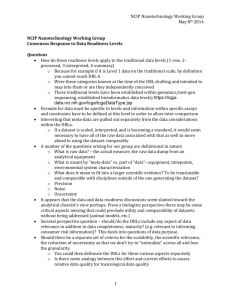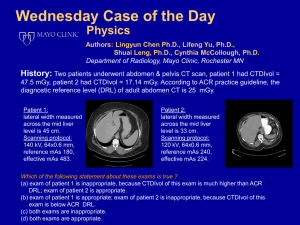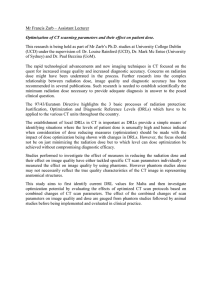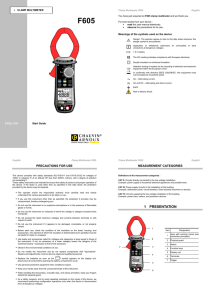Diagnostic Reference Levels (DRLs)
advertisement
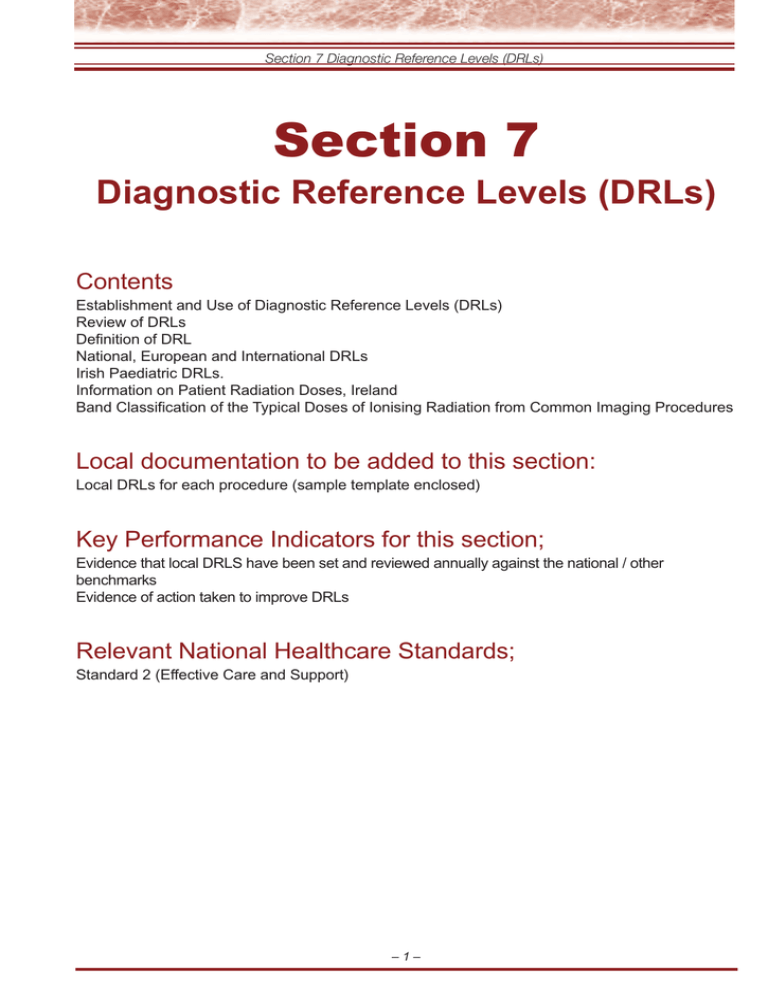
Section 7 Diagnostic Reference Levels (DRLs) Section 7 Diagnostic Reference Levels (DRLs) Contents Establishment and Use of Diagnostic Reference Levels (DRLs) Review of DRLs Definition of DRL National, European and International DRLs Irish Paediatric DRLs. Information on Patient Radiation Doses, Ireland Band Classification of the Typical Doses of Ionising Radiation from Common Imaging Procedures Local documentation to be added to this section: Local DRLs for each procedure (sample template enclosed) Key Performance Indicators for this section; Evidence that local DRLS have been set and reviewed annually against the national / other benchmarks Evidence of action taken to improve DRLs Relevant National Healthcare Standards; Standard 2 (Effective Care and Support) –1– Section 7 Diagnostic Reference Levels (DRLs) Section 7 Diagnostic Reference Levels (DRLs) Establishment and Use of Diagnostic Reference Levels (DRLs) Diagnostic Reference Levels (DRLs) have been established for the most common Irish procedures. The DRL is generally determined as the 75th percentile of the average relevant dose measure for that procedure. Service providers are required to establish and use DRLs for each of their routine procedures. Review of DRLs DRLs should be reviewed annually or when there is a significant change in protocol or where they are consistently exceeded. The review of DRLs should compare local with national or referenced averages and a note made of any significant variances to these averages and the justification for it. The local DRLs can be higher or lower than the national DRLs depending on the imaging equipment available to them or the patient casemix of that location. This regular review provides opportunity to provide feedback to ensure good practice in medical exposures is maintained. A sample template to record and review CT DRLs for locations is under local documentation in this section. This template can be adapted to set DRLs for locations for all diagnostic procedures. Locations should keep a record of their average doses, their DRLs and annual figures on patient activity. This information will be requested from locations to assist in determining medical ionising radiation doses received by the Irish population. Definition of DRL “Diagnostic reference levels” means dose levels in medical radio-diagnostic practices or in the case of radio-pharmaceuticals, levels of activity, for typical examinations for groups of standardsized patients or standard phantoms for broadly defined types of equipment. These levels are expected not to be exceeded for standard procedures when good and normal practice regarding diagnostic and technical performance is applied. National, European and International DRLs The Medical Council is required to promote the establishment of DRLs and has published a position paper on DRLs in 2004 outlining DRLs for use; http://www.medicalcouncil.ie/AboutUs/Legislation/Medical-Ionising-Radiation/Diagnostic-Referance-Levels-03-12-2004.pdf. Since then, national surveys have produced average doses and from these, more recent DRLs can be established and are outlined below. These are the national benchmarks against which local DRLs can be compared. As new surveys are produced, these national DRLs will be reviewed. –3– Section 7 Diagnostic Reference Levels (DRLs) th th –4– Section 7 Diagnostic Reference Levels (DRLs) th th th References 1) Diagnostic Reference Levels. Dental Council 2) Population Dose from General X-ray and Nuclear Medicine 2010. HSE report 2012 3) Population Dose from CT Scanning 2009. HSE report 2011 4) Preliminary results, Population Dose from PET_CT. HSE MERU 201340 5) Preliminary results, Population Dose from Interventional Radiology. HSE MERU 201341 European DRLs were established by the Dose Datamed II project undertaken by the European Commission. The results were published in 2013 and are available here; http://ddmed.eu/_media/news:ddm2_project_report_supplement_drls_final_draft_on_web_page _28_jan_2013.pdf Guidance on diagnostic reference levels in Nuclear Medicine is available from ARSAC. Administration of Radioactive Substances Advisory Committee (ARSAC); www.arsac.org.uk/42 –5– Section 7 Diagnostic Reference Levels (DRLs) Paediatric DRLs Particular attention needs to be given to establish separate DRLs for paediatrics for different ages. Below are recommended DRLs for paediatric CT. There are a number of published research articles on paediatric DRLs available in Ireland or internationally which should be taken in to account when setting a benchmark from which to compare local DRLs. th References 4. Population Dose from CT Scanning, 2010. –6– Section 7 Diagnostic Reference Levels (DRLs) Information on Patient Radiation Doses, Ireland43 Typical effective doses, equivalent periods of natural background radiation and lifetime fatal cancer risks from most common diagnostic medical exposures. * where Irish data is not available reference data from the UK4 has been used #based on 5% per Sv within age group 18-64years 1) Radiation Doses Received by the Irish Population, RPII, 2008. 2) Medical Exposure Radiation Unit Publications on CT, Dental, General and Nuclear Medicine Patient Radiation Doses, 2009 – 2013; 3) National Cancer Registry of Ireland (NCRI) (www.ncri.ie) 4) 2007 recommendations of the International Commission on Radiological Protection ICRP Publication 103, Annals of the ICRP vol 3744 5) Patient Dose Information, Public Health England website45, http://www.hpa.org.uk/Topics/Radiation/UnderstandingRadiation/UnderstandingRadiationTo pics/MedicalRadiation/medic_TedEquivalent/ –7– Section 7 Diagnostic Reference Levels (DRLs) Band Classification of the Typical Doses of Ionising Radiation from Common Imaging Procedures Typical effective doses for radiological examinations and associated risks as presented in “iRefer Making the Best us of Clinical Radiology” V 7.0.1. Royal College of Radiologists. The average annual background dose in most parts of Europe falls within the 1-5mSv range . Cancer risks from radiation vary considerable with age and sex, with higher risks from radiation vary considerably with age and sex, with higher risks in infants and females. Cancer risk indicated in this table is averaged for adults. This should be taken in the context of the considerably higher 1 in 3 average lifetime risk for cancer and must be balanced against the benefit of the investigation. [Key: US=ultrasound; MRI=magnetic resonance imaging; CXR=chest X-ray; XR=X-ray; IVU=intravenous urography; NM=nuclear medicine; CT=computed tomography; PET-CT=positron emission tomography co-registered with CT.] –8– Section 7 Diagnostic Reference Levels (DRLs) Local Documentation for Section 7 Diagnostic Reference Levels (DRLs) Insert: Local DRLs for every procedure Annual number of patients per common procedures for all modalities. NOTE: If the local documentation is not held in this file please indicate where it is held and ensure that it can be easily accessed upon request and readily available to the relevant personnel. Document Title Location Held Section 7 Diagnostic Reference Levels (DRLs) Sample Template to record and monitor local DRLs (can be adapted for all exams) Local Diagnostic Reference Levels (DRLs), CT exams Location: _______________________________________ Location Diagnostic Reference Levels have been reviewed and compared to reference standards. I recommend their adoption for this location for the year ____. CT Procedures Reference 1 DLP mGy.cm Brain 950 Cervical Spine 470 Hi Res Thorax 890 Thorax 460 Abdomen/ Pelvis 640 Thorax/ Abdomen/ Pelvis Location DRL DLP mGy.cm Where local DRL is higher than national or reference DRL, give justification: 850 Notes for completion: * The Medical Exposure Radiation Unit recommends the use of Irish CT Dose Survey DRLs where available and Medical Council DRLs for other studies where available. International studies can be referenced for the remainder of exams. State origin of international DRL. Complete this table and list all CT procedures conducted at location. Justify all variances to the reference DRL, in particular where local DRLs are higher. Recommended by: (print name), _____________________________ Practitioner in Charge Signed: _____________________________ Approved by: (print name), _____________________________ Chief Executive Officer Signed: _____________________________ Date: _____________________________ Notify: File: Review: Radiation Safety Committee, all relevant staff Local Rules / Radiation Protection File Annually or when there is a significant change to protocol Reference 1 Population Dose from CT Scanning 2009. HSE report 2011 – 11 –
